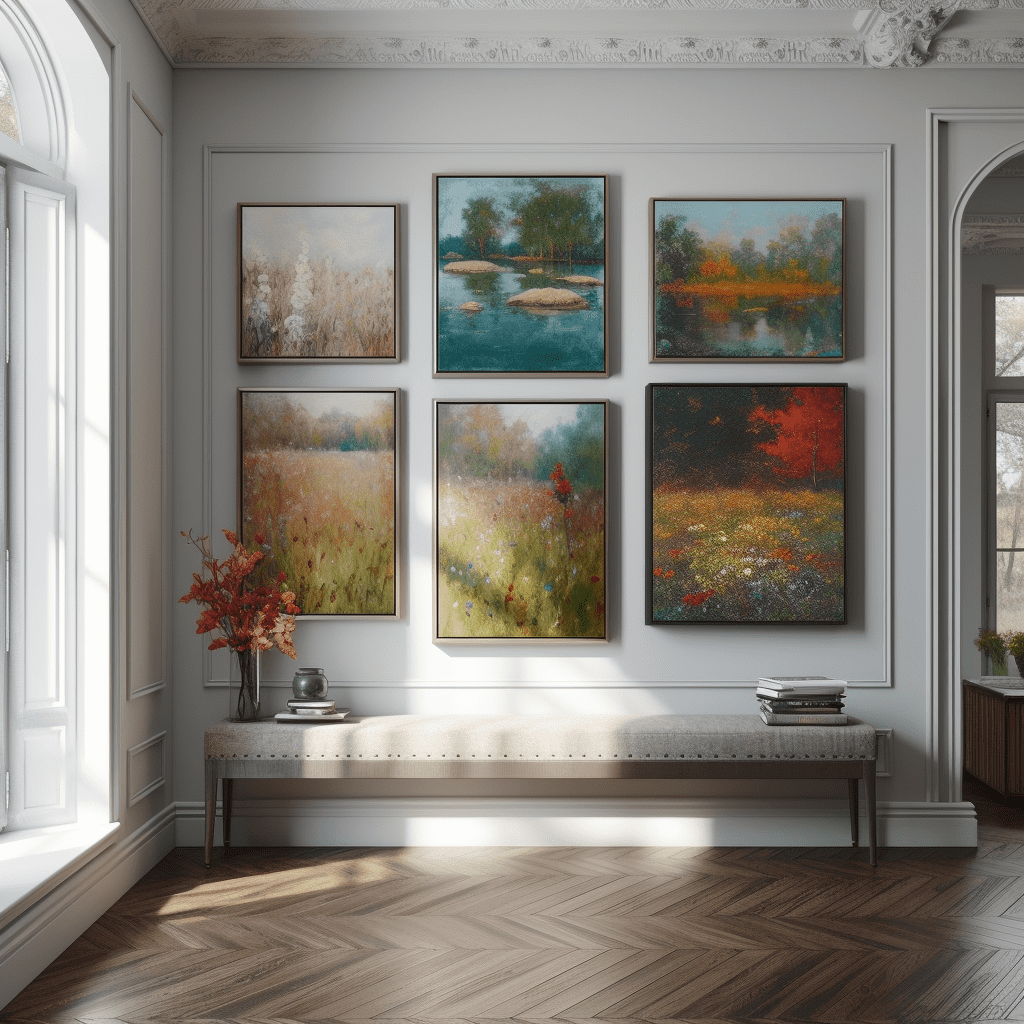Framing Watercolor Paintings: Tips and Tricks for a Professional Finish
Hey there, watercolor paint enthusiast! If you're looking for some tips on how to frame your beautiful masterpieces, I'm here to help. As an experienced framer of watercolor paintings, I have some great advice that'll make sure your artwork is displayed in its best light. In this article, I'll be taking you through the steps needed to properly and safely frame a piece of watercolor art. From choosing the right materials and tools to adding those extra special touches - by the end of it all, your framed masterpiece will look just as stunning as it did when first painted! So let's get started with framing that gorgeous work of art.
Materials Needed
I'm here to help you frame your watercolor painting like a pro! Let's start by gathering the materials needed. You'll need acid-free watercolor paper, canvas board or stretcher bars, framing materials, mounting tape, and hanging hardware. Make sure that all of these supplies are archival quality and don't contain acids that could damage your artwork over time.
Now it's time to prepare the canvas for framing. Start by making sure the surface is clean and free from dust or dirt. If there are any bumps or uneven surfaces, use sandpaper to smooth them out before we move on to the next step. Next, measure the size of your painting and cut the paper or canvas down to fit perfectly within the chosen frame size. Finally, secure the artwork in place with mounting tape so it won't shift while being framed up. And now that our preparation work is done... let's get started on actually framing up this masterpiece!
Preparing The Canvas

Now that you've gathered all the necessary materials for framing your watercolor painting, it's time to prepare the canvas. As an expert in this field, I recommend taking extra care when preparing your artwork for conservation framing. The first step is to select a frame that complements your piece and also preserves its delicate nature. It's important to choose a frame made of archival-grade materials such as wood or metal since they are designed to protect your painting from any potential damage over time.
Additionally, using acid-free mats can extend the life of your artwork by preventing fading and discoloration.
Once you have selected a frame and matting, take measurements and cut them accordingly so they fit snugly around your painting. If you plan on hanging the framed artwork, make sure to use mounting hardware specifically designed for heavy pieces like yours. Using nails or screws that are too small won't be able to support the weight of the assembled frameset! Finally, check if everything fits properly before securing it with tape or glue – this will keep your art safe until it’s ready for display. With these tips in mind, selecting an appropriate matting should be easy!
Selecting A Matting

Many people don't think about matting when framing their watercolor paintings, but it really can make a big difference in the finished product. Picking the right matting for your painting is an important step that shouldn't be overlooked! When selecting a matting, there are several things to consider. You should start by considering the colors of the painting and then select a coordinating color scheme for the matting.
Darker mats will help emphasize light-colored artwork while lighter mats can draw attention to darker tones. Additionally, you'll want to decide on which materials would best enhance your piece—whether it's rag paper or card stock—and whether single or double mats work better with your art. Finally, don’t forget to explore all of your options when choosing frames and other accessories like fillets. With so many choices available these days, you're sure to find something that perfectly suits your needs as well as your unique style! Moving onto choosing the right frame...
Choosing The Right Frame
Now that you have selected the perfect matting for your watercolor painting, it's time to choose the frame. With so many options available on the market today, it can be overwhelming trying to decide which one is best for your artwork. Here are some helpful tips when selecting a frame:
- Choose a frame material that compliments the watercolor painting. Wood frames are popular and more traditional choices, but there are also modern metal or plastic frames available in various colors and finishes. Consider choosing something different than what everyone else has as this will make your artwork stand out from others.
- Make sure the size of the frame suits your art piece properly. Too small of a frame will leave too much border showing around your painting whereas a larger frame may overpower or distract from it. You want to find something that perfectly complements the look and feel of your work without stealing away attention from it.
- Decide whether you prefer a simple design or an ornate one; this choice should reflect both personal preference and how well it ties into the overall aesthetic of your room decor or office space where it will hang eventually. If unsure about style, go with something neutral like black or white tones as these tend to work with any type of wall color scheme or interior decorations easily without drawing too much attention away from other elements in the area.
- Pay close attention to details like corner joints, screw holes, etc., as these all contribute to making sure your frame will last long-term without having any issues down the road such as bowing or warping due to poor-quality materials used during the construction process(es). Doing research beforehand about reputable brands who specialize in custom framing services can help narrow down the selection even further if needed!
Once you've chosen the right frame for your watercolor painting, mounting and hanging it correctly is essential for ensuring its longevity over time - we'll explore this topic next!
Mounting And Hanging

Mounting and Hanging a watercolor painting is an important step in the framing process. Doing it correctly ensures that your beautiful work of art will be displayed safely for years to come. I'm going to share with you some tips on how to best mount and hang your painting so that it looks great, while also preserving its condition.
Mounting | Hanging |
|---|---|
Acid-free mat | Hooks |
Foam core | Nails |
Adhesive tape | Picture hangers |
Spacers | Wire |
When mounting a watercolor painting, use acid-free materials like foam core or self-adhesive mats. These are both lightweight but sturdy enough to keep the artwork secure without damaging it. Once the backing material has been applied, use spacers around all four sides of the frame to ensure there’s no contact between the glass and the paper which could cause discoloration over time. Finally, adhere adhesive tape along each spacer edge before attaching them to the backboard using small nails or screws. This method creates room for air circulation which helps preserve your artwork from heat and humidity damage.
For hanging a framed watercolor painting, most people prefer using picture hangers attached directly to wall studs as they provide extra support against shifting or falling off due to vibrations caused by external sources such as wind or nearby construction projects. If this isn’t possible then try using wire instead which can be hooked onto two hooks secured firmly into the drywall at either side of the frame top – just make sure they’re spaced apart correctly so that they don't put too much strain on one another.
Alternatively, you may want to think about installing cleats that allow you to adjust the height of your painting if needed - these should always be used when displaying heavier images since they're more durable than the traditional methods mentioned above.
Whatever type of hardware you decide on, always double-check that it's securely fastened before you hang up your masterpiece! With careful planning and attention to detail, you'll have your watercolor painting mounted and hung in no time - looking perfect for many years ahead!
Conservation Framing Techniques
Did you know that over 15 million watercolor paintings have been created in the United States alone? As a result, it’s important to ensure these artworks are properly framed and preserved. Conservation framing techniques will help your painting stay beautiful for years to come!
When it comes to conservation framing, there are two main components: preservation materials and preservation techniques.
Preservation Materials:
- Matting: The matboard used should be acid-free or archival quality and preferably made of cotton rag or alpha cellulose fibers. This helps protect the artwork from any acidic material that may cause discoloration over time.
- Backing Board: A backing board should also be acid-free and is usually thicker than the mat board so it provides additional support for the artwork.
Preservation Techniques:
- Mounting Methods: It's best to use reversible mounting methods such as heat setting tape instead of using glue, foam core boards, pins, etc., which can damage the artwork if removed later on.
- Glass Covers: Non-glare glass covers provide UV protection from sunlight while also reducing reflections from indoor lighting. Plexiglass coverings are an alternative option with more flexibility as they don't break easily but do not offer UV protection as regular glass does.
With so many materials and techniques available, conservation framing offers plenty of options when preserving your masterpiece! Not only will it keep your painting safe from dust or dirt build-up, but it'll also make sure its vibrant colors last for generations to come!
Custom Framing Options

When it comes to framing your watercolor painting, there are so many custom framing options available. With unique framing designs and unique matting options, you can create a frame that truly brings out the beauty of your painting. Whether you choose from decorative frames or something more simple, the sky's the limit when it comes to designing a custom frame for your artwork.
At picture framing services, experienced professionals will work with you to design a frame that is perfect for your painting. They will provide expert advice on what type of material would be best for preserving your artwork as well as any special features like fillets or ornate corners that could bring out the detail in your piece. When everything has been selected, they’ll use their experience and skill to craft an original frame that perfectly captures the spirit of your painting.
No matter which style of Watercolor painting you have created, making sure it is properly framed is essential in protecting its beauty and integrity over time. If done correctly by experts with quality materials, it will not only protect but enhance its appearance while also allowing it to stand out even more amongst other pieces of art.
Conclusion
It's amazing how the right frame can completely transform a watercolor painting. With just a few simple steps, you can create something truly special that will last for years to come. When framing your artwork, it's important to think about both aesthetic and practical considerations. Conservation techniques such as using acid-free matting and UV protective glass are essential when looking after your treasured pieces. For those who want something extra special, custom frames offer unique options like beveled edges or detailed carvings to make your piece stand out from the rest. Did you know that over 95% of all art is displayed without any form of protection? By taking time to properly frame your work, you're ensuring its longevity so that future generations can appreciate it too! Whether you choose pre-made molding or bespoke designs, spending some time on getting the perfect frame for your masterpiece will pay off in spades.






